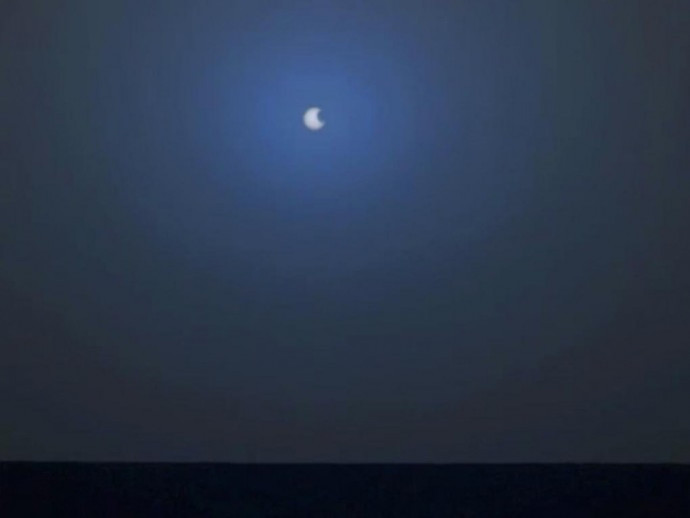NASA Makes Eclipse Movie On Mars

NASA may have found a way for filmmakers to go on location to Mars.
Using a set of images picked up by the Mars rover Opportunity, a team of researchers was able to make a movie clip of a Martian sunset as well as a transit of Mars' moon, Phobos, as it partially eclipses the sun.
Mars is known as the 'red planet' and the sky is usually a yellowish or orange color. But a person looking towards the sun would see a blue glow, said Mark Lemmon, a planetary scientist at Texas A&M University and a member of the rover science team.
The blue color comes from the dust particles in the Martian atmosphere, which are just the right size to scatter blue wavelengths forward, towards the observer. On Earth, the same effect happens in areas around forest fires, because smoke particles are a similar size.
The pictures come from the rover's panoramic camera, or Pancam. Lemmon worked with Pancam lead scientist Jim Bell, of Cornell University in Ithaca, N.Y., to plot the shots and make the moving-picture simulation from images taken several seconds apart.
The sunset movie, combining exposures taken Nov. 4 and Nov. 5, 2010, through different camera filters, accelerates about 17 minutes of sunset into a 30-second simulation. One of the filters is specifically used to look at the sun. Two other filters used for these shots provide color information.
Even though the two Martian moons are closer to Mars than the Moon is to Earth, both are too small to fully cover the face of the sun, as seen from the surface of Mars. (Phobos is only about 16 miles [37 kilometers] across). Bell and Lemmon chose a transit by Phobos shortly before Martian sunset on Nov. 9. A set of exposures was taken four seconds apart and combined into 30 second, eclipse movie.
While the pictures are interesting in and of themselves, the team was doing some real science with them, Lemmon said. We're trying to look at how light is scattering in the atmosphere, he said. That would provide valuable information about how dust is layered in the atmosphere, how big the particles are, and how high they go.
That information provides valuable clues as to Martian weather. The other Mars rover, Spirit, got dusty very quickly, Lemmon noted, and eventually the solar panels were so covered that the rover shut down for lack of power. Opportunity didn't get dusty nearly as fast. Future missions need to take the weather into account.
The images of Phobos also show where the tiny moon is relative to both the sun and Mars; that shows the variations in its orbit which in turn give clues as to the interior structure of Mars.
.
© Copyright IBTimes 2024. All rights reserved.





















